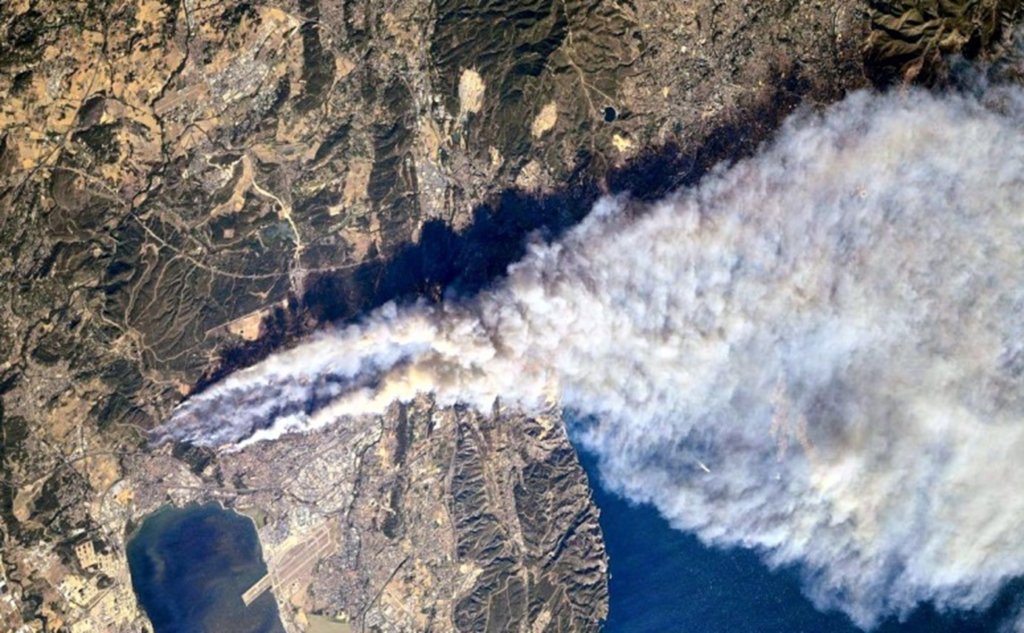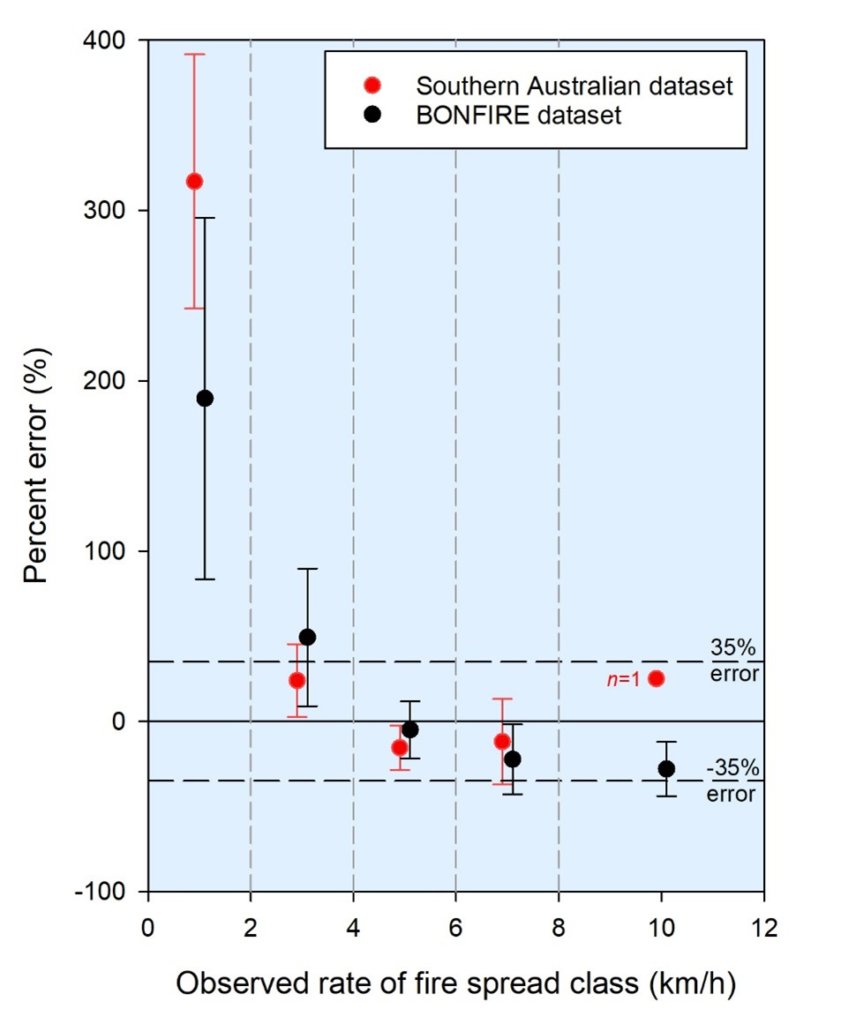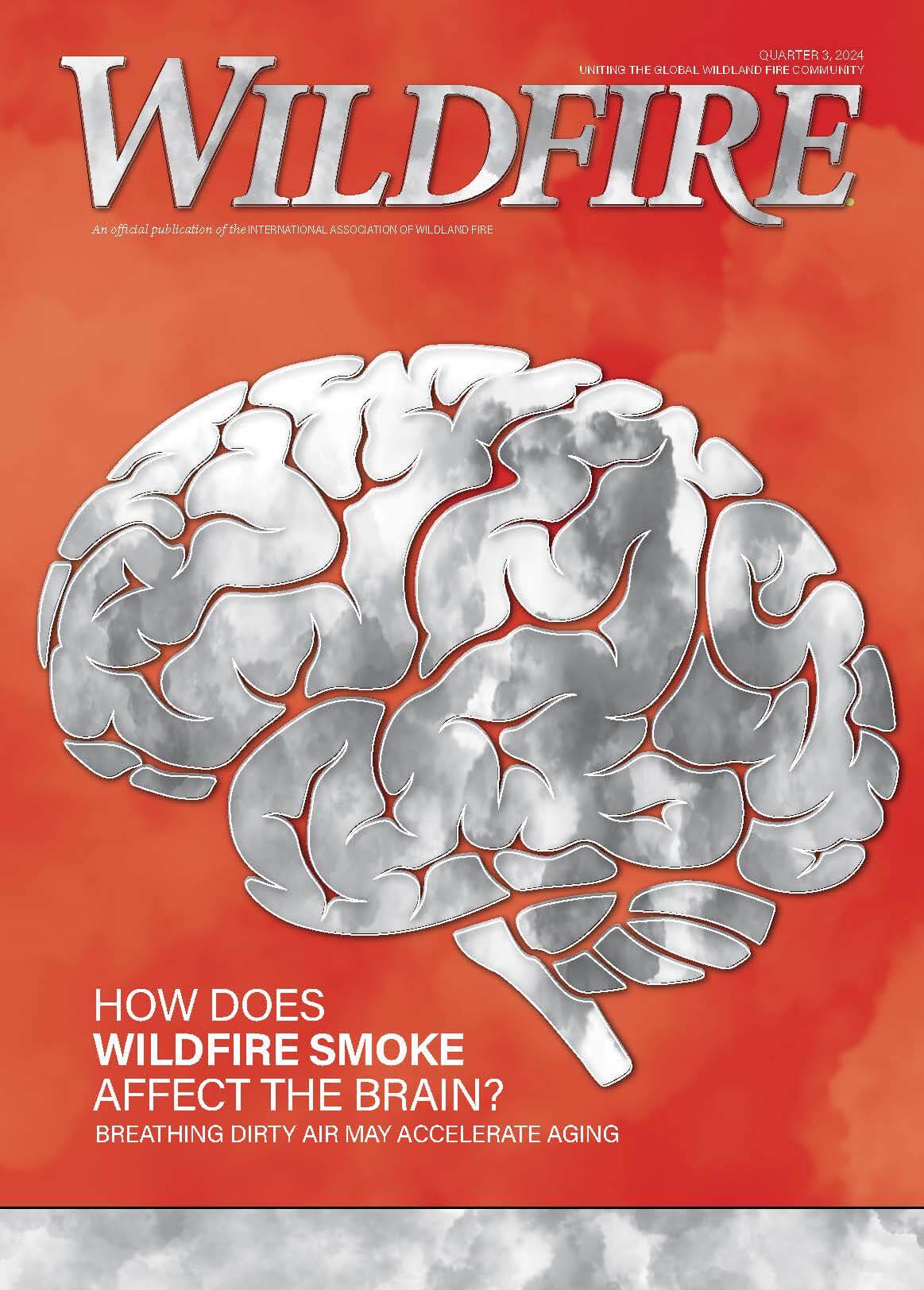Evaluating the 10% Wind Speed Rule of Thumb for Estimating a Wildfire’s Forward Spread Rate
By Miguel G. Cruz and Martin E. Alexander

INTRODUCTION
In the October-December 2019 issue of WILDFIRE, we described a recently developed rule of thumb for estimating a wildfire’s forward spread rate when burning conditions are severe, namely when wind speeds are high and fuels are critically dry, and the time available to prepare a more exacting prediction is limited (Alexander and Cruz 2019). Based on the analysis of three distinct
datasets comprising 118 high-intensity wildfire runs from around the world in forests (conifer- and eucalyptdominated) and shrublands, rate of spread was considered to be roughly 10% of the prevailing 10-m (33-ft) open wind speed, independent of the unit system used (Cruz and Alexander 2019). For example, given an open wind speed of 25 km/h (16 mi/h), the estimated wildfire spread rate during severe burning conditions would be approximately 2.5 km/h (1.6 mi/h).
Here we present a summary of an evaluation study that analyzed the predictive accuracy of the 10% rule of thumb against two large, independent wildfire datasets. For further details on the study, see Cruz et al. (2020).
THE INDEPENDENT DATA SOURCES
Documented observations of wildfire rate of spread were extracted from two different databases totalling 350 wildfire runs. The analysis focused on the wildfires spreading under the influence of strong wind speeds (i.e. >30 km/h or 19 mi/h) and low fine dead fuel moisture contents (i.e. <7%). The application of this filter reduced the data used in the analysis to 88 fire runs. Thirty of these
runs came from a database of fires in native eucalypt forests of southern Australia compiled by researchers from the Monash University in collaboration with the Country Fire Authority (CFA) and the Department of Sustainability and Environment of Victoria (Harris et al. 2011; Kilinc et al. 2012). The rates of fire spread and corresponding wind speeds ranged from 0.8-8.0 km/h (0.5-5.0 mi/h) and 30- 100 km/h (19-62 mi/h), respectively.
The second dataset consisted of 58 fire runs in shrublands, eucalypt forests and conifer forests garnered from the BONFIRE global fire behaviour database project led by the Universidade de Trás-os-Montes e Alto Douro (UTAD) in Vila Real, Portugal, starting in 2015 (Fernandes et al. 2020). The rates of fire spread and corresponding wind speeds ranged from 0.55-12.5 km/h (0.3-7.8 mi/h) and 30-80 km/h (19-50 mi/h), respectively.
MAIN OUTCOMES OF THE ANALYSIS
- The analysis of the performance of the 10% rule of thumb against wildfires spreading during severe burning conditions revealed the following:
- Its predictive accuracy is comparable to other evaluation studies of empirical fire spread models using wildfire data.
No significant differences were observed in error trends between the three fuel types considered (i.e. shrublands, conifer forests and eucalypt forests). - An over-prediction bias was detected for fires that spread at rates of less than 2.0 km/h (1.2 mi/h). This was also observed in the original analysis related to the development of the rule of thumb.
- It works best for wildfires spreading at rates greater than 2.0 km/h (1.2 mi/h) with most fires predicted within ±35% error prediction band. Prediction error, expressed as a percent of the observed rate of fire spread, was found to decrease in absolute terms with increasing rates of fire spread (Figure 1; see Box 1 for an interpretation of percent error).

THE DOMINANT CONTROL OF WIND SPEED DURING SEVERE BURNING CONDITIONS
The results of the Cruz et al. (2020) study have substantiated the strong control that wind speed exerts on the forward spread rate of wildfires when fuels are critically dry (i.e. both fine dead fuel moisture and overall long-term landscape dryness) and winds are strong. These burning conditions produce the type of fires that typically surprise emergency response agencies and communities as a result of their fast spread rates and corresponding high fireline intensities. Despite the high energy release rates associated with wildfires burning during these conditions, the convective plume tilt associated with the strong winds leads to a decoupling between the advancing flame front at the surface and the plume downwind that seems to reduce fire-plume interactions and the associated uncertainty with respect to weather conditions at the surface.
CLOSING REMARKS
The 10% rule of thumb was developed to provide first approximations of wildfire propagation rates for situations when there is little or no time to apply more comprehensive and accepted fire behavior prediction methods. As shown in the evaluation study, its application works well for the dry and windy conditions associated with fast-spreading wildfires, but will result in large over-predictions when applied in low to moderate wind speeds (i.e. <20 km/h or 12 mi/h) and fine dead fuel moisture conditions >7%.
ACKNOWLEDGEMENTS
Thanks to Paulo Fernandes (UTAD), Musa Kilinc (CFA) and Ângelo Sil (UTAD) for their contributions to the 10% rule of thumb evaluation study and to Matt Plucinski and Andrew Sullivan (CSIRO) for their comments on a draft of this article. Vincent Pastor with the Service Départemental d’Incendie et de Secours – 13, Bouches-du-Rhône, France, kindly provided details on the 2016 Rognac Fire.
REFERENCES
Alexander, M.E. and M.G. Cruz. 2019. A rule of thumb for estimating a wildfire’s forward spread rate. Wildfire 28(5): 36-39.
Cruz, M.G. and M.E. Alexander. 2013. Uncertainty associated with model predictions of surface and crown fire rates of spread. Environmental Modelling & Software 47: 16-28.
Cruz, M.G. and M.E. Alexander. 2019. The 10% wind speed rule of thumb for estimating a wildfire’s forward rate of spread in forests and shrublands. Annals of Forest Science 76(2): 44. 11 p.
Cruz, M.G., M.E. Alexander, P.M. Fernandes, M. Kilinc and Â. Sil. 2020. Evaluating the 10% wind speed rule of thumb for estimating a wildfire’s forward rate of spread against an extensive independent set of observations. Environmental Modelling & Software 133: 104818. 15 p.
Fernandes, P.M., Â. Sil, C.G. Rossa, D. Ascoli, M.G. Cruz and M.E. Alexander. 2020. Characterizing fire behavior across the globe. In: Hood, S., S. Drury, T. Steelman and R. Steffens (Editors),
The Fire Continuum – Preparing for the Future of Wildland Fire: Proceedings of the Fire Continuum Conference, 2018 May 21-24, Missoula, MT. Proceedings RMRS-P-78. Fort Collins, CO:
US Department of Agriculture, Forest Service, Rocky Mountain Research Station. pp. 258-263.
Harris, S., W. Anderson, M. Kilinc and L. Fogarty. 2011. Establishing a link between the power of fire and community loss: the first step towards developing a bushfire severity scale. Report
89. Melbourne, VIC: Victorian Government, Department of Sustainability and Environment. 75 p.
Kilinc, M., W. Anderson and B. Price. 2012. The applicability of bushfire behaviour models in Australia. Technical Report 1. Melbourne, VIC: Victorian Government, Department of Sustainability and Environment, DSE Schedule 5: Fire Severity Rating Project. 60 p.
ABOUT THE AUTHORS – The two of them have been cooperating on various projects for the the past 24 years.

Marty Alexander is a semi-retired Canadian wildland fire behavior researcher ([email protected]).


